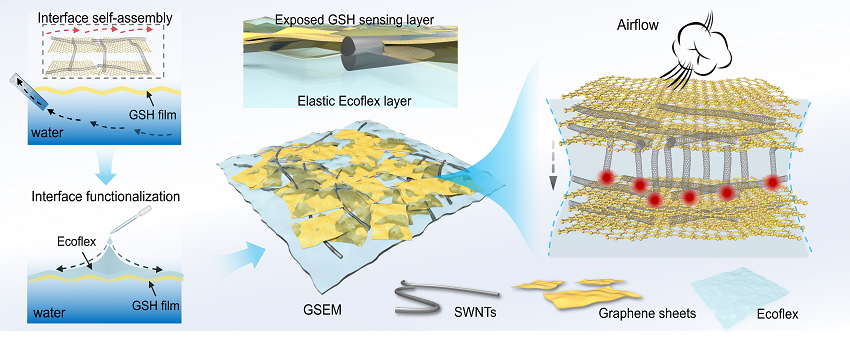Prof. CHEN Tao’s team at the Ningbo Institute of Materials Technology and Engineering (NIMTE) of Chinese Academy of Sciences (CAS) developed a flexible and self-adaptive airflow sensor enabled by bioinspired thin-membrane, which is mediated by the reversible microspring effect. The study was published in Advanced Functional Materials.
Airflow sensors based on mechanical deformation mechanism have drawn increasing attention recently, thanks to their excellent flexibility and sensitivity. However, fabricating highly sensitive and self-adaptive airflow sensors via facile and controllable methods still remains a challenge.
Inspired by the bats’ wing membrane, which shows unique airflow sensing capacity, researchers at NIMTE prepared graphene/single-walled nanotubes (SWNTs)-Ecoflex membrane (GSEM), which can be arbitrarily transferred and subsequently adapt to diverse flat/bend and smooth/rough surface.
By virtue of the reversible microspring effect, researchers developed a highly sensitive and self-adaptive GSEM-based airflow sensor.
When airflow was applied, the microscale deformation of interlayer SWNTs led to significant variation of contact resistance, endowing the developed GSEM-based airflow sensor with superior properties including the ultralow airflow velocity detection limit (0.0176 m s-1), fast response time (~ 1.04 s) and recovery time (~ 1.28 s).
As proof of concept, the GSEM-based airflow sensor can be employed to realize noncontact manipulation. Via a threshold controll, it was applied to a smart window system to successfully realize the intelligent open and close behaviors.
In addition, researchers designed an array of airflow sensors to differentiate the magnitude and spatial distribution of the applied airflow stimulus. Integrated into a wireless vehicle model system, the GSEM-based airflow sensor can sensitively capture the flow velocity information to realize real-time manipulation of motion direction.
This microspring effect-based airflow sensing system shows great potential in the fields of wearable electronics and noncontact intelligent manipulation.
The research was supported by the Natural Science Foundation of China (No. 52073295 and 51803226), Sino-German Mobility Program (No. M-0424), Key Research Program of Frontier Sciences, Chinese Academy of Sciences (No. QYZDB-SSWSLH036), Bureau of International Cooperation, Chinese Academy of Sciences (No. 174433KYSB20170061), and K.C.Wong Education Foundation (No. GJTD-2019-13).

Fig. Schematic of the preparation, structure and sensing principle of GSEM for airflow sensing (Image by NIMTE)
Contact
ZHOU Wei
Ningbo Institute of Materials Technology and Engineering
E-mail: zhouwei@nimte.ac.cn

